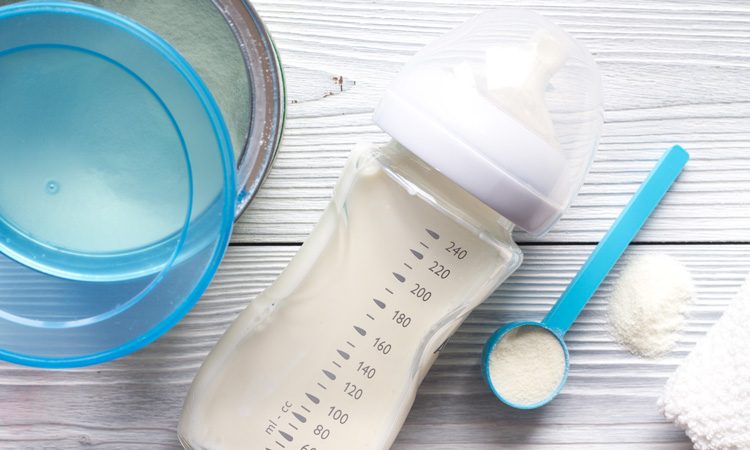Technology can take infant nutrition to the next level
- Like
- Digg
- Del
- Tumblr
- VKontakte
- Buffer
- Love This
- Odnoklassniki
- Meneame
- Blogger
- Amazon
- Yahoo Mail
- Gmail
- AOL
- Newsvine
- HackerNews
- Evernote
- MySpace
- Mail.ru
- Viadeo
- Line
- Comments
- Yummly
- SMS
- Viber
- Telegram
- Subscribe
- Skype
- Facebook Messenger
- Kakao
- LiveJournal
- Yammer
- Edgar
- Fintel
- Mix
- Instapaper
- Copy Link
Posted: 8 April 2022 | Rachelle Neumann | No comments yet
Giving humans the best start in life not only benefits the health of those humans, but the world too. Here, Rachelle Neumann explains how new technological advancements can take baby formula to the next level.


Imagine the launch of a magical product, Nutrio Pellets, which claimed to provide the entire daily nutritional intake for an adult human in one easily digestible tablet. It would quickly be relegated to the realms of science fiction, for the benefits of just one well-balanced meal – let alone three – cannot be replaced by mere pellets. It is simply not possible to receive the abundance of vitamins, minerals and other nutrients available in real food from a single pellet; any pack of multivitamins will tell you, it “is not an alternative to a balanced diet.” And then, of course, there are the psychological and emotional benefits that eating a variety of different types of food has on human development and wellbeing.
While such a notion may sound absurd in terms of adult diets, it is nevertheless something of a reality for millions of babies around the world – and has been for decades since the introduction of infant formula.
‘Breast is best’ – but not always an option
Scientists are unanimous in their agreement that breast milk is the optimum source of nutrition for babies, providing all the nutrients essential for their early growth and development. The World Health Organization recommends that babies be exclusively breastfed for the first six months of their lives1– a practice that has proven to have a positive effect on the nursing child, both physically and psychologically.
As a source of nutrition that has evolved to meet babies’ needs in an optimal way, breast milk and the act of breastfeeding provides multiple benefits. Breastfed babies have been shown to have stronger immune systems; are less likely to suffer from gastrointestinal disorders, such as diarrhoea, constipation and gastroenteritis; are less prone to infections, including bacterial meningitis; and suffer fewer respiratory illnesses, such as pneumonia and whooping cough. Breastfed babies also have lower rates of sudden infant death syndrome and are generally less prone to illnesses requiring hospitalisation.2
Breastfeeding also provides a pivotal role for the estimated 15 million (one in 10) babies born preterm every year.3For these infants, breast milk is a literal lifesaver, providing a tenfold increase in survival rates for preterm babies.
However, there are numerous reasons why many women either do not or cannot breastfeed; in fact, less than 50 percent of babies are exclusively breastfed up to the age of six months, per the WHO recommendations. Reasons range from physical and psychological issues that prevent the mother from lactating or make it unsafe for them to nurse, to economic and social reasons that have become more prominent in recent decades, whereby women cannot necessarily take leave from their jobs for the entire first six months of a child’s life.
Thus, alternatives to mothers’ milk have been used for millennia. and animal milk was given to babies in prehistoric times4 to supplement breast milk, until the introduction of the first infant formula in the mid-nineteenth century. Some 160 years later, formula is still the next-best option – for many, the only option – to provide babies with the necessary nutrients without the need for the mother to nurse. The formula industry has made great advances since its inception, yet it still has a way to go.


Breast milk is recommended by the WHO for the first six month of a child’s life
Adequate, but not a winning ‘formula’
For years, formula has been the most prevalent solution for mothers unable to breastfeed full time, or at all. While it does provide an adequate replacement for breast milk, much like our imaginary Nutrio Pellets, it has long been established that there is a crucial element inherent in breast milk that, despite all of today’s technological advancements, remains missing from the various infant formula options currently available.
The composition of infant formulas bears some similarities to human milk, such as possessing macro ingredients in the requisite ratios of fats, proteins and sugars.5 However, technological advances, combined with our increased understanding of the science of food and nutrition over recent decades, make it clear that manufactured formulas lack comparable nutritional value to human milk.
Human milk contains not only the more easily replicated macro nutrients, but also bioactive molecules. These not only give milk its structure, texture and taste but also provide that ‘conversation’ between the mother and child, which occurs through both direct breastfeeding, as well as via expressed human milk. These bioactive molecules influence the growth, development and metabolic activity of the nursing child, and cannot be replicated in animal milk or plant-based breast milk substitutes.6
There is now conclusive evidence that the lack of bioactive components can lead to adverse effects for infants.7 Research shows that babies who are fed only breast milk alternatives are more prone to experiencing changes in their microbiome, developing inflammatory syndromes like asthma and atopic dermatitis, have slower cognitive development (up to the age of two), and experience higher incidences of fever and diarrhoea, to name a few examples.
Between a rock and a hard place
We therefore find ourselves in something of a catch-22 situation. Breast milk is best for babies, but not all women are able or willing to nurse, and safe access to donor breast milk is not an option for many. While infant formula can serve as a substitute, it has not been able to provide infants with everything that human milk does.
It is therefore incumbent on society in general, and the food-tech industry in particular, to find a solution. This solution must include, without compromise, nutrients in the same concentration as breast milk, as well as identical composition of non-nutritive bioactive molecules currently only available in sufficient quantities in human breast milk.8 These are simply absent from current replacements and, despite all the advancements of modern science, there is still no way to synthetically replicate the bioactive molecules inherent in human milk.
The answer lies at the source
The solution to ensuring that all babies receive equal nutritional and developmental advantages may lie within the very source of breast milk – the mammary cells themselves.
Recent breakthroughs in the field of food science are now allowing researchers to isolate and cultivate these mammary cells in lab conditions, and ‘programme’ them to secrete the milk components found in natural human milk. The result is the ability to produce the whole spectrum of nutrients and bioactive ingredients found in breast milk – all without the need for the actual act of classic lactation. Each of these ingredients can be used to supplement formulas with specific nutrients, or with the entire range of natural breast milk components.
Our current and ongoing reliance on infant formula will remain. However, while infant formulas can be optimised to include nutritional ingredients derived from human milk, this will only be possible via cell-cultured human milk.
By harnessing emerging technologies to supplement existing formulas with those bioactive molecules, we can forget the fanciful Nutrio Pellets. Instead, we will soon be able to produce infant formulas that are as close to the real thing as possible. Improving existing formulas in this way can improve the nutrition of babies globally. Particularly in the case of preterm babies, it could mean the difference between life and death.
References
- WHO Fact Sheet on Infant and Young Child Feeding: https://www.who.int/news-room/fact-sheets/detail/infant-and-young-child-feeding
- Cleveland Clinic, The Benefits of Breastfeeding for Baby and for Mom: https://my.clevelandclinic.org/health/articles/15274-the-benefits-of-breastfeeding-for-baby–for-mom
- WHO Fact Sheet on Preterm Birth: https://www.who.int/news-room/fact-sheets/detail/preterm-birth
- https://www.bbc.co.uk/news/science-environment-49813039
- Breastfeeding: more than just good nutrition: https://www.semanticscholar.org/paper/Breastfeeding%3A-more-than-just-good-nutrition.-Lawrence-Lawrence/a48ce8f7bbb86ea765423d3ac9980cf0a87bf0bd/figure/3
- Human Milk Composition: Nutrients & Bioactive Factors: https://www.ncbi.nlm.nih.gov/pmc/articles/PMC3586783/
- Ibid. https://www.ncbi.nlm.nih.gov/pmc/articles/PMC3586783/
- Ibid. https://www.ncbi.nlm.nih.gov/pmc/articles/PMC3586783/
About the author
Rachelle Neumann is Chief Marketing Officer and Corporate Affairs Executive at bio-FoodTech company Wilk Technologies. She has over two decades of experience leading high performing teams in the HealthTech, industrial and consulting sectors, and has been a trusted advisor to management teams of Fortune 500 companies. Rachelle is a Certified Public Accountant, has an MBA from the University of Southern California, and has been awarded several leadership and digital marketing certificates from Harvard Business School, New York University and The Wharton School.




